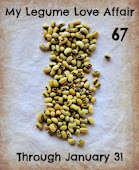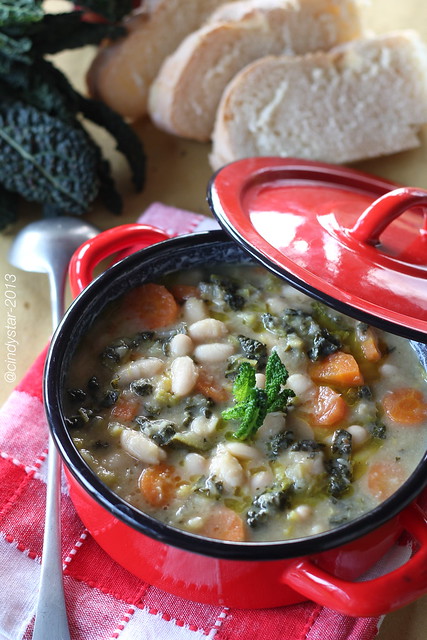La Signora Ribollita - Tuscan Ribollita - MLLA # 67
Una delle mie zuppe preferite, una ricetta che sa di casa e sapori antichi.
Sicuramente ognuno cela la propria ricetta personale, aggiungendo/togliendo questo o quello, come la mia(nostra) cara amica Grazia, che per tradizione non manca mai di festeggiare il suo soggiorno elbano con tutta la compagnia con la spiaggiata più attesa dell'anno, gioiosamente riuniti intorno al suo pentolone di ribollita fatta con tanta cura e amore.
Si dice ribollita perchè una volta veniva fatta in grandi quantità, e riscaldata nei giorni seguenti, diventando sempre più gustosa ogni volta che la si ribolliva.
Da qui il consiglio di farla sempre almeno un giorno prima di degustarla, tenendola abbastanza morbida per avere poi la consistenza giusta quando si aggiungerà il pane (che comunque non è obbligatorio, si può anche degustare così al naturale).
Pane che ho imparato ad affettare sottilmente, su consiglio di mia cugina, fiorentina doc: in questo modo si amalgamerà meglio e più velocemente, lasciando la zuppa più morbida.
Si possono usare fagioli borlotti, cannellini o toscanelli, sia freschi che secchi, a seconda della loro reperibilità stagionale.
Ingredienti:
cipolla, sedano e carota per il soffritto
fagioli secchi cannellini o borlotti
olio extravergine di oliva
verza, cavolo cappuccio, cavolo nero,
cipolla, carote, sedano, bietole, patate,
zucchine (quando in stagione)
un cucchiaio o due di salsa di pomodoro, facoltativo
sale/pepe o dado homemade
peperoncino, se piace
finocchio selvatico, se piace
pane toscano raffermo
un cucchiaio o due di salsa di pomodoro, facoltativo
sale/pepe o dado homemade
peperoncino, se piace
finocchio selvatico, se piace
pane toscano raffermo
Mettere a bagno i fagioli per una notte se si usano quelli secchi.
L'indomani eliminare quelli risaliti in superficie, risciacquarli e cuocerli in pentola a pressione per circa 15 minuti dal fischio in abbondante acqua, con un rametto di rosmarino e uno di salvia legati insieme (cuocendoli in pentola normale il tempo di cottura si allunga a un'ora, un'ora e mezza).
Non buttare questa acqua che servirà per cuocere la zuppa.
Far rosolare cipolla, sedano e carota tritati finemente per il soffritto.
Aggiungere tutte le verdure mondate e tagliate, iniziando da verze e cavoli, una per volta (la salsa di pomodoro per ultima, se usata), far appassire, allungare quindi con l'acqua di cottura dei fagioli. Tritare 2/3 dei fagioli lessati e aggiungerli alla zuppa, il resto dei fagioli interi andrà aggiunto a cottura quasi ultimata.
Salare e pepare (o insaporire col dado homemade), eventualmente aggiungere il peperoncino/finocchio selvatico a piacere.
Portare a cottura le verdure, in pentola a pressione cuocere 20/30 minuti dal fischio, altrimenti in pentola normale lasciare sobollire per un'ora e mezza circa.
E' meglio se fatta il giorno prima, così le verdure riposano e i sapori si amalgamano bene.
Mezzora prima di servire disporre nella zuppiera uno strato di zuppa ben calda, uno di pane a fette tagliate molto sottili, un altro di zuppa, un altro di pane e finire con la zuppa e lasciare riposare coperta per circa 10/15 minuti.
Tuscan Ribollita
Definetely one of my favorite soups, full of traditional home flavors.
And for that everyone hides his personal recipe, with a little more or less of this and that.
Ribollita means boiled twice as once it was made in large quantities, and re-heated in the following days, becoming more and more delicious every day after.
So get yours the suggestion to make it at least a day in advance, and fluid enough if you plan to add the bread (which however is not mandatory, you can also serve it without).
I've learned from my Florentine cousin to slice thinly the bread: in this way he will fit in better and faster, leaving the soup softer.
You can use borlotti beans, cannellini or toscanelli, both fresh or dried, depending on their seasonal availability .
And for that everyone hides his personal recipe, with a little more or less of this and that.
Ribollita means boiled twice as once it was made in large quantities, and re-heated in the following days, becoming more and more delicious every day after.
So get yours the suggestion to make it at least a day in advance, and fluid enough if you plan to add the bread (which however is not mandatory, you can also serve it without).
I've learned from my Florentine cousin to slice thinly the bread: in this way he will fit in better and faster, leaving the soup softer.
You can use borlotti beans, cannellini or toscanelli, both fresh or dried, depending on their seasonal availability .
You need:
onion, celery and carrot for soffritto
dried beans or cannellini beans
extra virgin olive oil
cabbage, kale,
carrot, onion, celery, chard, potato,
zucchini (when in season)
dried beans or cannellini beans
extra virgin olive oil
cabbage, kale,
carrot, onion, celery, chard, potato,
zucchini (when in season)
1 or 2 tbsp tomato sauce, optional
salt/pepper or homemade stock cubes
chili, if you like
fennel, if you like
leftover Tuscan bread
salt/pepper or homemade stock cubes
chili, if you like
fennel, if you like
leftover Tuscan bread
(or any rustic bread)
Soak the beans overnight if using dried ones .
The next day remove those recovered to the surface, rinse and cook in a pressure cooker for about 15 minutes from the whistle with plenty of water, with a sprig of rosemary and sage tied together (if using a regular pot cooking time will be an hour, an hour and a half).
Do not throw away cooking water, will be used for the soup.
Sauté onion, celery and carrot, finely chopped.
Add all chopped vegetables, one at a time, starting with cabbage and kale, amalgamating the previous with the following (tomato sauce the last, if used), then add the bean cooking water. Blend 2/3 of the cooked beans and add to the soup, the remaining will be added when the soup is done.
Add salt and pepper (or season with homemade stock cubes), optionally add a little chili/fennel at your pleasure.
Cook the vegetables in a pressure cooker for 20/30 minutes from the whistle , otherwise in a regular pot let simmer for an hour and a half.
As said before, better if made in advance, all vegetables and flavors will nicely amalgamate.
Half an hour before serving, arrange a layer of piping hot soup in a large bowl, place sliced bread, again soup, then again bread and repeat till you come to the top of the bowl: let stand covered for about 10/15 minutes then serve.
The next day remove those recovered to the surface, rinse and cook in a pressure cooker for about 15 minutes from the whistle with plenty of water, with a sprig of rosemary and sage tied together (if using a regular pot cooking time will be an hour, an hour and a half).
Do not throw away cooking water, will be used for the soup.
Sauté onion, celery and carrot, finely chopped.
Add all chopped vegetables, one at a time, starting with cabbage and kale, amalgamating the previous with the following (tomato sauce the last, if used), then add the bean cooking water. Blend 2/3 of the cooked beans and add to the soup, the remaining will be added when the soup is done.
Add salt and pepper (or season with homemade stock cubes), optionally add a little chili/fennel at your pleasure.
Cook the vegetables in a pressure cooker for 20/30 minutes from the whistle , otherwise in a regular pot let simmer for an hour and a half.
As said before, better if made in advance, all vegetables and flavors will nicely amalgamate.
Half an hour before serving, arrange a layer of piping hot soup in a large bowl, place sliced bread, again soup, then again bread and repeat till you come to the top of the bowl: let stand covered for about 10/15 minutes then serve.

This recipe goes to Brigida for My Legume Love Affair # 67, both for English and Italian edition, the international event created in 2008 by Susan of The Well-Seasoned Cook and now organized by Lisa of Lisa’s Kitchen.
















8 commenti:
buonissima! :)
Davvero!
Grazie e buon w.e.! ;-)
Una bontà, sarà anche che c'è il cavolo nero che adoro ma sta zuppa è tra le preferite! :)
terry, anche se magari sembra che sia di parte per le mie radici toscane, adoro anche io il cavolo nero, ed ora ho anche trovato e provato il cavolo fiolaro, buonissimo, e il cavolo di Custoza, ua varietà particolare delle mie zone semilacustri.
Chissà che non riesca a postare qualche bella ricettina ;-)
Buona domenica!
Grazie per il suggerimento riguardante il pane: la prossima volta che faccio la ribollita lo mettero' in atto di sicuro. Certamente questo e' uno dei piatti piu' buoni che si possono mettere in tavola, soprattutto d'inverno. Grazie per il contributo a WHB.
Simona, grazie a te ;-)
Buonissima settimana!
This looks so healthy and light! I like the greens and the beans being the star. Will have to give ribolitta a try!
Dela, thanks,
and I'm sure you will be fully satisfied! ;-)
Please give me a little note when you try :-)
Posta un commento
grazie della visita e gentilmente firma sempre i tuoi commenti!
thanks for passing by and please sign up your comments!